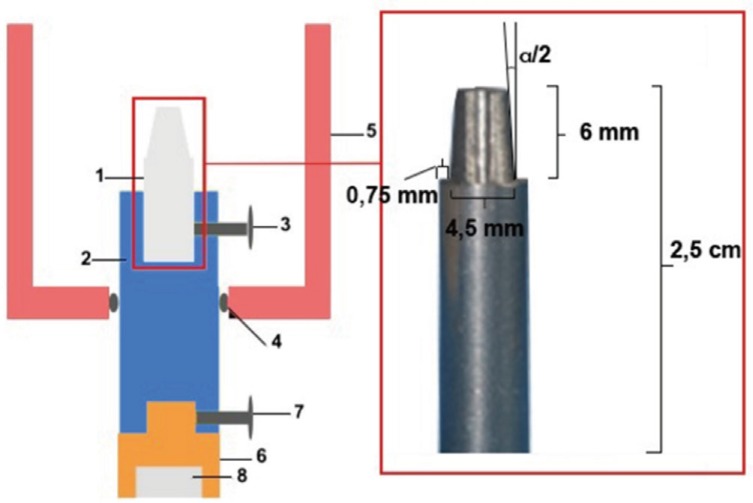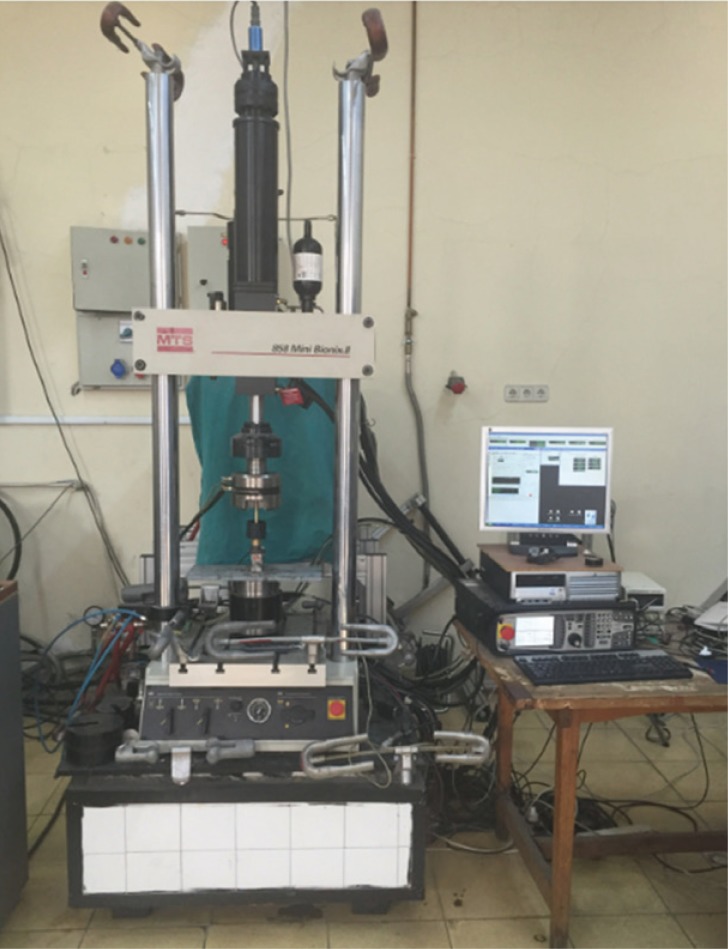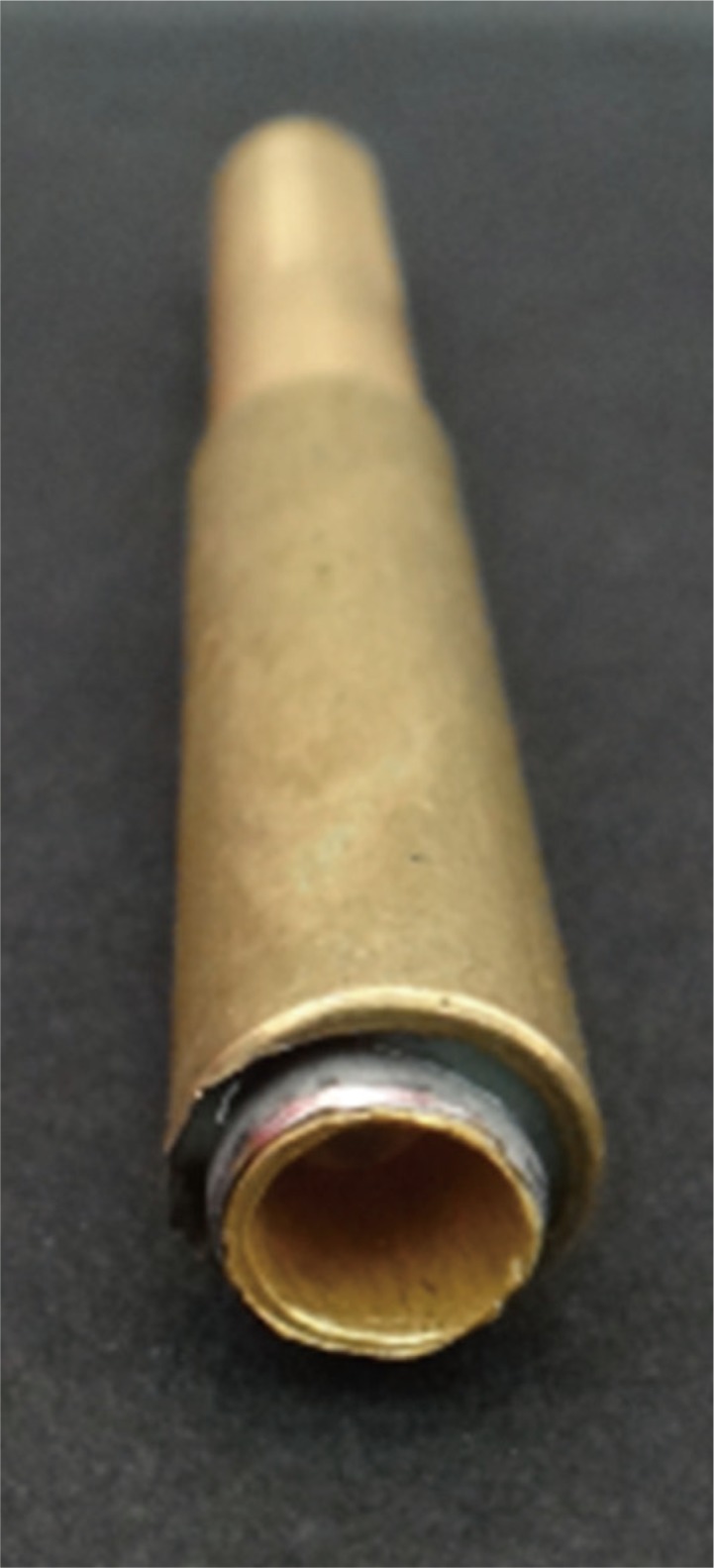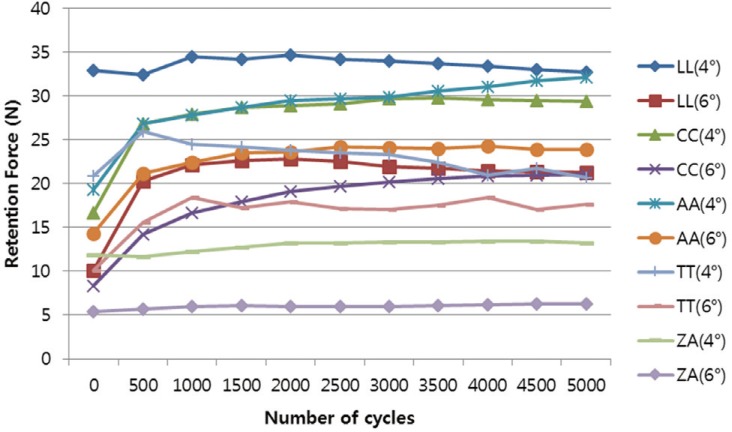J Adv Prosthodont.
2017 Aug;9(4):308-314. 10.4047/jap.2017.9.4.308.
Comparison of retention forces with various fabrication methods and materials in double crowns
- Affiliations
-
- 1Department of Prosthodontics, Faculty of Dentistry, Yeni Yüzyıl University, İstanbul, Turkey. melahatcelik_@hotmail.com
- 2Laboratory of Biomechanics, Faculty of Mechanical Engineering, Istanbul Techinical University,Ä°stanbul, Turkey.
- 3Department of Prosthodontics, Faculty of Dentistry, Istanbul University, Ä°stanbul, Turkey.
- KMID: 2398079
- DOI: http://doi.org/10.4047/jap.2017.9.4.308
Abstract
- PURPOSE
The purpose of this study was to analyze the retention force changes and wear behaviours of double-crown systems over long-term use.
MATERIALS AND METHODS
Ten groups, each consisting of six samples, were evaluated. Specifically, casting gold alloy primary crown - casting gold alloy secondary crown (AA), laser sintering primary crown - laser sintering secondary crown (LL), casting Cr alloy primary crown - casting Cr alloy secondary crown, (CC) zirconia primary crown - electroformed secondary crown (ZA), and CAD/CAM titanium alloy primary crown - CAD/CAM titanium alloy secondary crown (TT) groups were evaluated at cone angles of 4° and 6°. The samples were subjected to 5,000 insertion-separation cycles in artificial saliva, and the retention forces were measured every 500 cycles. The wear levels were analyzed via SEM at the beginning and end of the 5,000 cycles.
RESULTS
In all samples, the retention forces increased when the conus angle decreased. The highest initial and final retention force values were found in the LL-4° group (32.89 N-32.65 N), and the lowest retention force values were found in the ZA6° group (5.41 N-6.27 N). The ZA groups' samples showed the least change in the retention force, and no wear was observed. In the other groups, wear was observed mostly in the primary crowns.
CONCLUSION
More predictable, clinically relevant, and less excursive retention forces can be observed in the ZA groups. The retention force values of the LL groups were statically similar to those of the other groups, except the ZA groups.
Keyword
MeSH Terms
Figure
Reference
-
1. Stancić I, Jelenković A. Retention of telescopic denture in elderly patients with maximum partially edentulous arch. Gerodontology. 2008; 25:162–167. PMID: 18194328.2. Bayer S, Stark H, Gölz L, Keilig L, Kraus D, Hansen A, Enkling N. Clinical retention force development of double crowns. Clin Oral Investig. 2012; 16:407–411.
Article3. Wöstmann B, Balkenhol M, Kothe A, Ferger P. Dental impact on daily living of telescopic crown-retained partial dentures. Int J Prosthodont. 2008; 21:419–421. PMID: 18950064.4. Weigl P, Hahn L, Lauer HC. Advanced biomaterials used for a new telescopic retainer for removable dentures. J Biomed Mater Res. 2000; 53:320–336. PMID: 10898873.
Article5. Igarashi Y, Goto T. Ten-year follow-up study of conical crown-retained dentures. Int J Prosthodont. 1997; 10:149–155. PMID: 9206455.6. Grossmann AC, Hassel AJ, Schilling O, Lehmann F, Koob A, Rammelsberg P. Treatment with double crown-retained removable partial dentures and oral health-related quality of life in middle- and high-aged patients. Int J Prosthodont. 2007; 20:576–578. PMID: 18069364.7. Beuer F, Edelhoff D, Gernet W, Naumann M. Parameters affecting retentive force of electroformed double-crown systems. Clin Oral Investig. 2010; 14:129–135.
Article8. Langer A. Telescope retainers and their clinical application. J Prosthet Dent. 1980; 44:516–522. PMID: 7003109.
Article9. Langer A. Combinations of diverse retainers in removable partial dentures. J Prosthet Dent. 1978; 40:378–384. PMID: 359788.
Article10. Gurbulak AG, Kilic K, Eroğlu Z, Gercekcioglu E, Kesim B. Evaluation of the retention force of double conical crowns used in combination with a galvanoforming and casting fabrication technique. J Prosthodont. 2013; 22:63–68. PMID: 22928873.
Article11. Korber KH. Das rationelle Teleskopsystem. ZWR. 1983; 92:38–43.12. Shimakura M, Nagata T, Takeuchi M, Nemoto T. Retentive force of pure titanium konus telescope crowns fabricated using CAD/CAM system. Dent Mater J. 2008; 27:211–215. PMID: 18540394.13. Turp I, Bozdağ E, Sünbüloğlu E, Kahruman C, Yusufoğlu I, Bayraktar G. Retention and surface changes of zirconia primary crowns with secondary crowns of different materials. Clin Oral Investig. 2014; 18:2023–2035.
Article14. Santos EC, Shiomi M, Osakada K, Laoui T. Rapid manufacturing of metal components by laser forming. Inter J Machine Tools Manufacture. 2006; 46:1459–1468.
Article15. Örtorp A, Jönsson D, Mouhsen A, Vult von Steyern P. The fit of cobalt-chromium three-unit fixed dental prostheses fabricated with four different techniques: a comparative in vitro study. Dent Mater. 2011; 27:356–363. PMID: 21163516.
Article16. Iseri U, Ozkurt Z, Kazazoglu E. Shear bond strengths of veneering porcelain to cast, machined and laser-sintered titanium. Dent Mater J. 2011; 30:274–280. PMID: 21597225.
Article17. Liu Y, Wang Z, Gao B, Zhao X, Lin X, Wu J. Evaluation of mechanical properties and porcelain bonded strength of nickel-chromium dental alloy fabricated by laser rapid forming. Lasers Med Sci. 2010; 25:799–804. PMID: 19548056.
Article18. Shannon IL. Fluoride treatment programs for high-caries-risk patients. Clin Prev Dent. 1982; 4:11–20.19. Ohkawa S, Okane H, Nagasawa T, Tsuru H. Changes in retention of various telescope crown assemblies over long-term use. J Prosthet Dent. 1990; 64:153–158. PMID: 2202814.
Article20. Engels J, Schubert O, Güth JF, Hoffmann M, Jauernig C, Erdelt K, Stimmelmayr M, Beuer F. Wear behavior of different double-crown systems. Clin Oral Investig. 2013; 17:503–510.
Article21. Bayer S, Zuziak W, Kraus D, Keilig L, Stark H, Enkling N. Conical crowns with electroplated gold copings: retention force changes caused by wear and combined off-axial load. Clin Oral Implants Res. 2011; 22:323–329. PMID: 20868454.
Article22. Widbom T, Löfquist L, Widbom C, Söderfeldt B, Kronström M. Tooth-supported telescopic crown-retained dentures: an up to 9-year retrospective clinical follow-up study. Int J Prosthodont. 2004; 17:29–34. PMID: 15008229.23. Behr M, Hofmann E, Rosentritt M, Lang R, Handel G. Technical failure rates of double crown-retained removable partial dentures. Clin Oral Investig. 2000; 4:87–90.
Article24. Behr M, Kolbeck C, Lang R, Hahnel S, Dirschl L, Handel G. Clinical performance of cements as luting agents for telescopic double crown-retained removable partial and complete overdentures. Int J Prosthodont. 2009; 22:479–487. PMID: 20095198.25. Bayer S, Stark H, Mues S, Keilig L, Schrader A, Enkling N. Retention force measurement of telescopic crowns. Clin Oral Investig. 2010; 14:607–611.
Article26. Güngör MA, Artunç C, Sonugelen M. Parameters affecting retentive force of conus crowns. J Oral Rehabil. 2004; 31:271–277. PMID: 15025661.
Article27. Besimo CH, Graber G, Flühler M. Retention force changes in implant-supported titanium telescope crowns over long-term use in vitro. J Oral Rehabil. 1996; 23:372–378. PMID: 8809690.
Article28. Lenz J. Ein mathematisches Modell zur Berechnung des Haftund Festigkeitsverhaltens von konischen Teleskopkronen. Dtsch Zahnaerztl. 1982; 37:7–15.29. Wagner C, Stock V, Merk S, Schmidlin PR, Roos M, Eichberger M, Stawarczyk B. Comparison of retention Forces of different fabrication methods of Co-Cr crowns: Presintered and milled, cast and electroforming secondary crowns with different taper angles. Int J Dent Oral Sci. 2015; 3:15–20.
- Full Text Links
- Actions
-
Cited
- CITED
-
- Close
- Share
- Similar articles
-
- Erratum: Comparison of retention forces with various fabrication methods and materials in double crowns
- The comparison of initial retentive force in different double crown systems
- A STUDY ON THE CHANGES IN RETENTION OF CLIPS USED TO RETAIN IMPLANT-SUPPORTED OVERDENTURE
- Effect of hemispherical dimples at titanium implant abutments for the retention of cemented crowns
- Prosthetic treatment for Down's syndrome patient with dental cross bite problem using maxillary double crown denture






